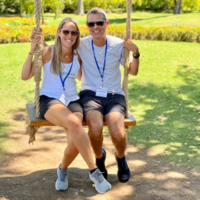These beaches have incredibly clear blue water and white sand. Because of Cuba’s lack of industrial development, wildlife thrives here, making it a colorful place for snorkeling and swimming.
When you stay in Cuba you can choose between state-run hotels and private homes called casas particulares. Hotels and resorts have superior beachfront real estate, but consider staying in a private residence for the chance to meet a Cuban family.
Varadero
Varadero is one of Cuba’s most popular beaches for visitors. This beach has a lengthy 12.5 miles (20 km) of sand.

Varadero offers a huge variety of kid-friendly beach activities. Sailing, kayaking, banana boats – your kids can try something new every day. In town you’ll find a bevy of tour operators and equipment rentals. Grownups can head out to the golf course or the discos near the beach.
While you’re in the area, go see the wildlife at the nearby Ciénaga de Zapata National Park. This park specializes in the environment between the land and the sea – it has wetlands, marshes, and swamps. Hike around the lake called Laguna de las Salinas to see pink flamingos strutting through the shallows.
Guardalavaca
Guardalavaca is a resort town near the city of Holguín. After Varadero, this is one of the most popular beaches in Cuba.
Shallow, calm, warm water makes Guardalavaca an easy place to go snorkeling or swimming with the kids. There are reefs a short distance from the shore – pop on your goggles and have a look at the underwater kingdom of tropical fish.

For an educational field trip visit the Chorro de Maíta Aboriginal Museum, located just a 6-minute drive from the beach. This museum’s property includes a burial site left behind by the native Taíno people. You’ll also see life-size recreations of Taíno village life.
Playa Santa Lucia
Coconut palms line the beach at Playa Santa Lucía. This beach is 12 miles (20 km) long. It can get pretty windy here, making it ideal for visitors who want to try sailing or wind surfing.

If you have older children you should arrange for a snorkeling or scuba diving trip to the reef that grows just a mile from the shore. Serious scuba divers should check out the sunken ships in the nearby bay. There is a steam ship called Mortera that sank here in 1898. You can also arrange for a tour to see bull sharks, and watch them feed from the safety of a boat.
Cayo Coco & Cayo Guillermo
You can drive to these beaches on a manmade causeway. They are both on the same narrow strip of land that juts out along Cuba’s north coast. Both Cayo Coco and Cayo Guillermo have all-inclusive resorts, but no nearby towns.

Near Cayo Coco you have a good chance of spotting some pink flamingos strutting in the shallows. At the Delfinario (Dolphin Center) you can swim with local dolphins in a well-maintained facility.
Cayo Guillermo is smaller and has fewer hotels than Cayo Coco, but it’s a good place to escape the crowds. On the northern tip of Cayo Guillermo you’ll find a beach called Playa Pilar. This bit of the Caribbean Sea is an especially pretty shade of aquamarine.
Trinidad and Playa Ancón
Playa Ancón is on the coast of Trinidad, which is a well-preserved colonial town. Trinidad has historic, pastel-colored buildings and cobblestone streets, and it offers an idealized glimpse of Cuba’s colonial past. The beach here is a popular place to bob around in the calm water.
From here you can take a 45-minute boat ride to an island called Cayo Blanco. It’s worth the trip just for the boat ride, and the coral reefs that surround the island make it a popular destination for snorkeling.


